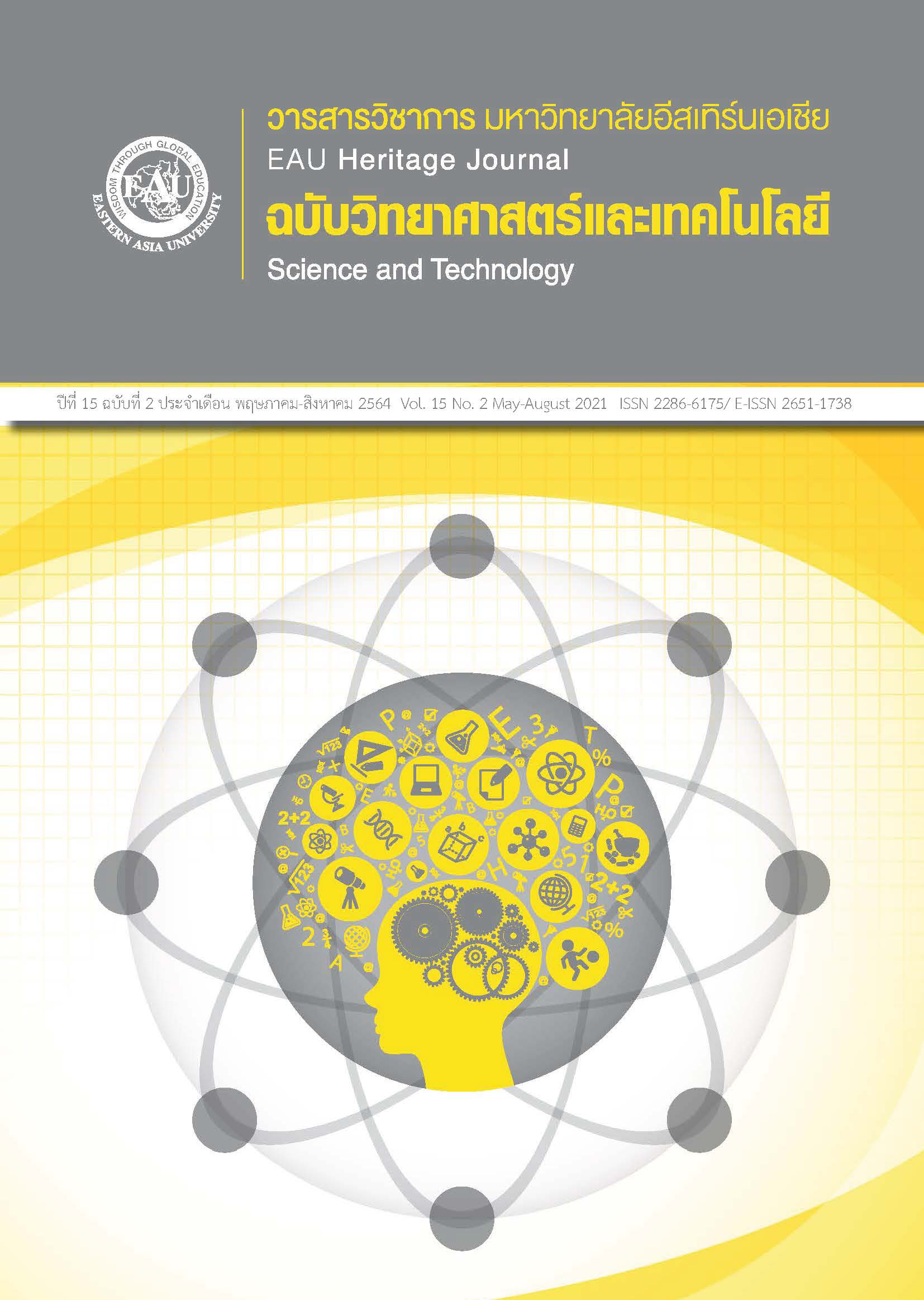การพัฒนาผลิตภัณฑ์แผ่นทำความสะอาดผิว แบบไม่ใช้น้ำ จากน้ำมันรำข้าว พืชเศรษฐกิจ เพื่อเพิ่มความชุ่มชื้นแก่ผิว
คำสำคัญ:
ผลิตภัณฑ์แผ่นทำความสะอาดผิวแบบไม่ใช้น้ำ, สารให้ความชุ่มชื้นผิว, ความชุ่มชื้นของผิว,น้ำมันรำข้าวบทคัดย่อ
การศึกษาวิจัยครั้งนี้เป็นการศึกษาวิจัยเชิงทดลอง (experimental research) มีวัตถุประสงค์ เพื่อพัฒนาผลิตภัณฑ์แผ่นทำความสะอาดผิวแบบไม่ใช้น้ำสำหรับเพิ่มความชุ่มชื้นของผิว ศึกษาประสิทธิภาพการเพิ่มความชุ่มชื้น และศึกษาความสัมพันธ์ระหว่างร้อยละการเพิ่มความชุ่มชื้นของผิวกับความพึงพอใจต่อผลิตภัณฑ์แผ่นทำความสะอาดผิวแบบไม่ใช้น้ำ ที่ใช้สารให้ความชุ่มชื้น คือ น้ำมันมะพร้าว น้ำมันรำข้าว และสารสกัดว่านหางจระเข้ วิธีการทดสอบ กลุ่มอาสาสมัครสุขภาพดี จำนวน 23 คน โดยให้อาสาสมัคร ใช้สูตรตำรับผลิตภัณฑ์ ทุกวันจันทร์–ศุกร์ ต่อสัปดาห์ทดลองใช้เป็นระยะเวลา 2 สัปดาห์ และประเมินค่าความชุ่มชื้นผิวด้วยเครื่องคอร์นิโอมิเตอร์ และศึกษาความพึงพอใจ ด้วยแบบสอบถามความพึงพอใจ และประเมินค่าความชุ่มชื้น ที่หลังใช้ตำรับผลิตภัณฑ์ ณ เวลา 15 นาที หลังใช้ 1 สัปดาห์ ละ หลังใช้ 2 สัปดาห์ พร้อมประเมินความพึงพอใจด้วยแบบสอบถาม ผลการทดลอง พบว่า ค่าความชุ่มชื้นของผิวของอาสาสมัครเพิ่มขึ้นอย่างมีนัยสำคัญทางสถิติที่ระดับความเชื่อมั่นร้อยละ 95 หลังใช้ผลิตภัณฑ์ เป็นระยะเวลา 2 สัปดาห์ โดยอาสาสมัคร 22 คน มีค่าความชุ่มชื้นของผิวเพิ่มขึ้น ใน 2 สัปดาห์ อยู่ในช่วงร้อยละ 11.56-87.74 ผลการศึกษาทดสอบความสัมพันธ์ พบว่า ร้อยละของค่าความชุ่มชื้นที่เพิ่มขึ้นของผิวอาสาสมัครไม่สัมพันธ์กับความพึงพอใจของอาสาสมัครที่ทดลองใช้ผลิตภัณฑ์ อาจจะเนื่องมากจาก ระดับการเพิ่มขึ้นของค่าความชุ่มชื้นน้อยเกินกว่าที่อาสาสมัครจำรับรู้ได้การเปลี่ยนแปลงของผิว ซึ่งผลการศึกษาครั้งนี้สามารถนำไปใช้เป็นแนวทางพัฒนาผลิตภัณฑ์แผ่นทำความสะอาดผิวแบบไม่ใช้น้ำ สำหรับเพิ่มความชุ่มชื้นของผิวในผู้สูงอายุหรือผู้ป่วยที่มีผิวแห้งต่อไป
เอกสารอ้างอิง
Aiempanakit, K. (2017). Skin problems. Retrieved from http://www.meded.psu.ac.th. (in Thai)
Bunthai, W., & Puangchan Daeng, S. (2012) Evaluation of physical and chemical properties of aloe vera leaves (Aloe barbadensis Miller). Journal of Agricultural Science, 43(3), 308-310. (in Thai)
Hashizume, H. (2004). Skin aging and dry skin. The Journal of Dermatology, 31(8), 603-9. https://doi.org/10.1111/j.1346-8138.2004.tb00565.x
Jennings, B. H., & Akoh, C. C. (2009). Characterization of a rice bran oil structured lipid. Journal of Agricultural and Food Chemistry, 57(8), 3346-3350. doi: 10.1021/jf803825m.
Juliano, C., Cossu, M. l., Alamanni, M. C., & Piu, L. (2005). Antioxidant activity of gamma-oryzanol: Mechanism of action and its effect on oxidation stability of pharmaceutical oils. International Journal of Pharmaceutics, 299(1-2). 146-154. doi: 10.1016/j.ijpharm.2005.05.018
Kasetsart University. (2020). Rice bran oil. Retrieved from: http://www.guru.sanook.com/5877/. (in Thai)
Kliangprom, J., & Putivanit, S. (2017). Prevention of skin breakdown in the older person. The Southern College Network Journal of Nursing and Public Health, 4(3), 249-258. (in Thai)
Klongpityapong, P., Supabphol R., Puksakit, W., & Chaiwichit, P. (2011). Cytotoxicity test on cancer cells of rice bran and germ oil. EAU Heritage Journal Science and Technology, 5(1), 48-55. (in Thai)
Klongpityapong, P., Supabphol, R., & Supabphol, A. (2013). Antioxidant effects of Gamma-Oryzanol on human prostate cancer cells. Asian Pacific Journal of Cancer Prevention, 14(9), 5421-5425. doi: 10.7314/APJCP.2013.14.9.5421
Klongpityapong, P., & Jaricksakulchai, J. (2019). Development of pharmaceutical preparation from rice bran oil for health promotion. EAU Heritage Journal Science and Technology, 13(2), 1-16. (in Thai)
Klongpityapong, P., Jaricksakulchai, J., Sillaparassamee, R., & Timmanee, I. (2020). Safety and effectiveness study of formulation containing rice bran oil with Gamma Oryzanol 18,000 ppm in improving skin barrier function and moisturization for dry skin. EAU Heritage Journal Science and Technology, 14(2), 290-307. (in Thai)
Ministry of Science and Technology. (2019). Meaning of rice bran oil. Retrieved from: http://www.mhesi.go.th/. (in Thai)
Olivarius, F. de F., Hansen, A. B., Karlsmark, T., & Wolf, H. C. (1996). Water protective effect of barrier creams and moisturizing creams: A new in vivo test method. Contact Dermatitis Environmental and Occupational Dermatitis, 35(4), 219-225. https://doi.org/10.1111/j.1600-0536.1996.tb02361.x
Petruk, G., Giudice, R. D., Rigano, M. M., & Monti, D. M. (2018). Antioxidants from plants protect against skin photoaging. Oxidative Medicine and Cellular Longevity, 2018(Special Issue), 1-11. https://doi.org/10.1155/2018/1454936
Plant Genetic Conservation Project. (2020). Properties of aloe vera. Retrieved from: http://www.medthai.com/. (in Thai)
Rimkeeree, H., Haruthaithanasan, V., & Rujira, P. (1997). Development of skin care cream from palm oil and aloe vera. Proceedings of the 35th Kasetsart University Annual Conference: Plant, Agricultural Extension and Communication and Agro-Industry (pp. 666-672). Bangkok: Kasetsart University. (in Thai)
Thuekaew, P. (2019). Coconut oil benefit. Retrieved from http://www.mhesi.go.th/. (in Thai)
Wanitphakdeedecha, R. (2019). PM. 2.5 skin effect. Retrieved from:http://www.si.mahidol.ac.th/. (in Thai)







